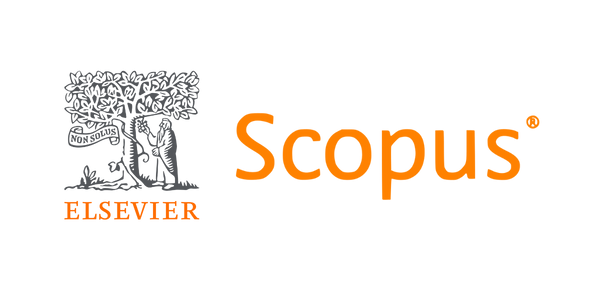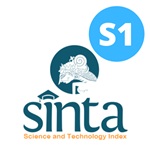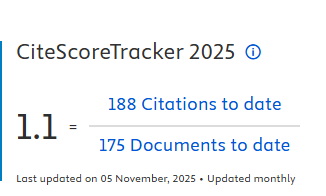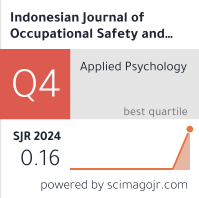GAMBARAN TINGKAT STRESS KERJA ANTAR SHIFT KERJA PADA PETUGAS PENGUMPUL TOL SURABAYA
Downloads
PT. (X), Surabaya is one of company that manages toll road or highway that implement the shift system of work. Shift work has the potential for job stress and other health problems. The purpose of this research was to identify descriptive the level of job stress between shift work at the toll collector in PT. (X), Surabaya. This research was an observational analytic study with cross sectional approach. 36 toll collector who work when the morning shift, afternoon, and evening at the toll gate x, toll gate y and toll gate z were chosen as sample by using Proportional Random Sampling method. The results showed when the shift I (morning) there were 15 respondents (41.7%) suffered mild job stress and 21 respondents (58.3%) suffered moderate job stress. At the shift II (evening) there were 12 respondents (33.3%) suffered mild stress of work and 24 respondents (66.7%) suffered moderate job stress, while at the shift III (evening) were 9 respondents (25%) suffered light work stress and 27 respondents (75%) suffered moderate job stress. Based on the research results, it can be concluded the level of job stress between of shift work on the toll collectors suffered mild and moderate stress. The greatest frequency of respondents suffered moderate job stress. Recommendation for the company is review the system of career development and maintaining training activities, while for workers is use the time to rest and regular exercise.
Keywords: job stress, shift work, toll collector
Andarika, R. 2004. Burnout Pada Perawat Putri RS St. Elizabeth Semarang Ditinjau dari Dukungan Sosial. Jurnal Psyche . Vol. 1. No. 1, 1–8.
Anoraga, P. 1992. Psikologi Kepemimpinan. Jakarta: Rineka Cipta.
Dinas Infokom Jatim. 2009. Volume Lalin Meningkat, Jasa Marga Maksimalkan CCTV. http://www.jatimprov.go.id. (sitasi 19 Februari 2015)
Eastman Kodak Company, Ergonomics Group. 1986. "Ergonomic Design for People at Work”, (Vol.2). New York: Van Nostrand Reinhold.
Friedman dan Ulmer. 1984. Treating Type a Behavior - And Your Heart. New York: Knopf.
Friedman dan Roseman. 1974. Type A Behavior And Your Heart. New York: Knopf.
Grandjean, E. 1988. Fitting The Task to The Man, a Text book of Occupational Ergonomics, 4th edition. London: Taylor and Francis Ltd.
Gunarsa, S D. 2008. Psikologi Perawatan. Jakarta: Gunung Mulia.
Hurlock, E. 2001. Psikologi Perkembangan Edisi Kelima. Jakarta: Erlangga.
Jasamarga. 2015. Produk dan Layanan Surabaya-Gempol. http://www.jasamarga.com/produk_dan_layanan/surabaya-gempol/ (sitasi 10 Juli 2015).
Martina, A. 2012. Gambaran Tingkat Stres Kerja Perawat di Ruang Rawat Inap Rumah Sakit Paru Dr. Moehammad Goenawan Partowidigdo Cisarua Bogor (RSPG). Skripsi. Depok: Universitas Indonesia.
Mc. Cormick, E.J and D.R. Ilgen. 1985. Industrial-Organizational Psychology. 8th ed. New Jersey: Prentice-Hall, Inc.
Munandar, A.S. 2001. Psikologi Industri dan Organisasi. Jakarta: Penerbit Universitas Indonesia (UI-PRESS).
National Institute of Occupational Safety and Health (NIOSH). 2000. Stess At Work. NIOSH Publication No. 99–101. http://www.cdc.gov/Niosh/stresswk.html (sitasi 30 Juni 2015).
Nazir, Moh. 1998. Metode Penelitian. Jakarta: Ghalia Indonesia.
Parasuraman., Greenhaus., Granrose, J.H. 1992. Role Stressors, Social Support and Well-being Among Two-Career Couples. Journal of Organizational Behavior. Vol. 13, No. 4, 339–356.
Ramayuli, S. 2004. Hubungan Faktor Individu dan Shift Kerja dengan Produktivitas Tenaga Kerja Wanita pada Bagian Pengepakan di PT. INDOFOOD Sukses Makmur Tbk. Cabang Medan Tahun 2004. Skripsi. Medan: Universitas Sumatra Utara.
Revalicha, N.S. dan Sami'an. 2013. Perbedaan Stres Kerja Ditinjau dari Shift Kerja pada Perawat di RSUD Dr. Soetomo Surabaya. Jurnal Psikologi Industri dan Organisasi. Vol. 2 No. 01,
–171.
Robbins, S.P. 2006. Perilaku Organisasi: Konsep, Kontroversi, Aplikasi. Jakarta: PT. Prenhallindo.
Santrock, J.W. 2003. Adolescene (6th edition). http://books.google.co.id.books?id=Z3LWSxbTv4C&printsec=frontcover#v=onepage&q&f=false. (sitasi 18 November 2014)
Saragih, E. 2010. Manajemen Stres Di Tempat Kerja. http://ppm-manajemen.ac.id/manajemen-stres-di-tempat-kerja/. (sitasi 18 November 2014)
Siboro, S.T. 2008. Hubungan Kondisi Kerja dan Karakteristik Individual dengan Stress Kerja pada Pegawai Lembaga Permasyarakatan Klas II B Lubuk Pakam 2008, 2009. Skripsi. Medan: USU Repository.
Suma'mur, P.K. 1994. Keselamatan Kerja dan Pencegahan Kecelakaan. Jakarta: CV. Haji Masagung.
Tayyari, F., dan Smith J. L. 1997. Occupational Ergonomics: Principles and Applications. London: Chapman & Hall.
Walker, J. 2002. Teens in Distress Series Adolescent Stress and Depression, Minnesota University. Available from: http://www.extension.umn.edu/distribution/youthdevelopment/DA3083.html (Accesed 4 March 2010)
Wildani, A.A. 2012. Gambaran Tingkat Stres Kerja Pada Pegawai Dinas Kesehatan Kota Depok. Skripsi. Depok: Universitas Indonesia.
Winarsunu, T. 2008. Psikologi Keselamatan Kerja. Malang: UMM Press.
Zahra, A.A. 2015. Analisis Tingkat Stress Kerja Antar Shift Kerja Pada Penjaga Pintu Tol di PT. Jasa Marga (Persero) Cabang Surabaya-Gempol. Skripsi. Surabaya: Universitas Airlangga.

In order to be accepted and published by The Indonesian Journal of Occupational Safety and Health, Author(s) who submit an article should complete all the review process. The copyright of received articles assigned to the The Indonesian Journal of Occupational Safety and Health and Department of Safety and Health, Universitas Airlangga as publishers of the journal. The intended copyright includes the rights to publish articles in various forms (including reprints).
The Editorial Team of The Indonesian Journal Of Occupational Safety and Health and Department of Safety and Health strive to ensure that no errors occur in the articles that have been published, both data errors and statements in the article.
Users of this website will be licensed to use materials from this website following the Creative Commons Attribution-NonCommercial-ShareAlike 4.0 International License. No fees charged. Please use the materials accordingly.
------------------------------------------------------------------------------------------------------------------------------------------------------------------------------------------
Attribution ” You must give appropriate credit, provide a link to the license, and indicate if changes were made. You may do so in any reasonable manner, but not in any way that suggests the licensor endorses you or your use.
NonCommercial ” You may not use the material for commercial purposes.
ShareAlike ” If you remix, transform, or build upon the material, you must distribute your contributions under the same license as the original.







 How to Submit Articles in OJS
How to Submit Articles in OJS

























